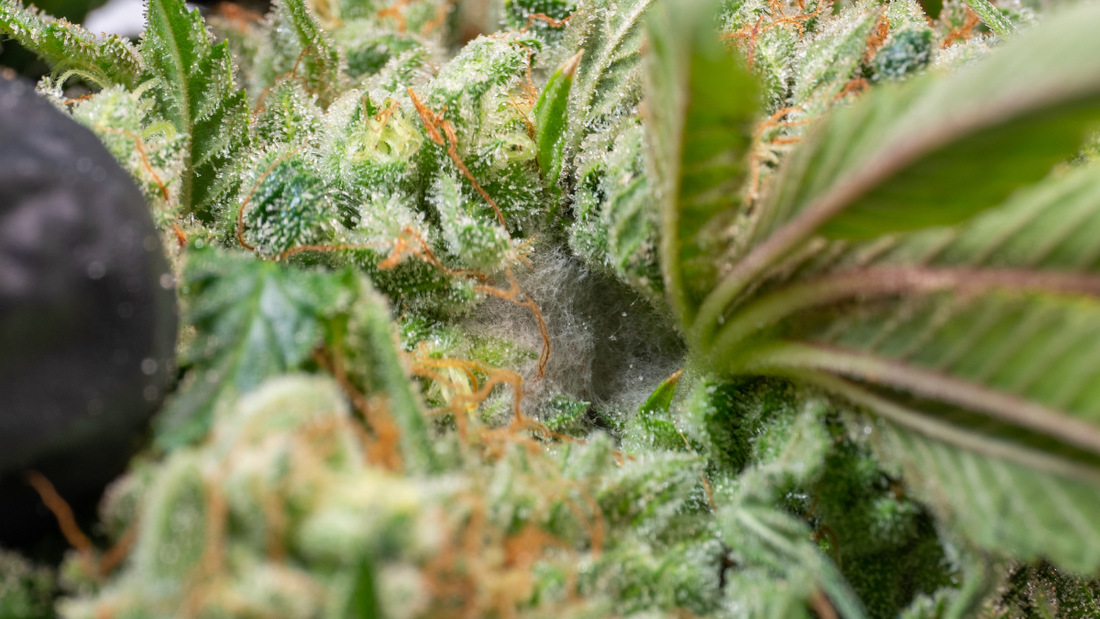Pourriture des bourgeons ou Botrytis, moisissure grise

Botrytis
L’automne signifie se réveiller avec des matins frais et humides et même si cela peut être une pause agréable dans les nuits étouffantes d’été, cela peut être une période décisive pour les cultivateurs en extérieur. C'est cette période de l'année où les bourgeons prennent du volume, mais les conditions fraîches et humides sont également les conditions parfaites pour que le Botrytis s'établisse puis se propage rapidement et ruine une récolte. Bien qu'elle soit beaucoup plus courante dans la culture en extérieur, elle n'est pas rare dans un environnement contrôlé, et elle devrait donc également être sur le radar des cultivateurs en intérieur.

Le Botrytis est l’une des infections les plus faciles à diagnostiquer. Comme pour tout type d’infection, la clé est de diagnostiquer tôt afin d’en minimiser l’impact. Dans ce cas, soyez attentif aux feuilles supérieures qui jaunissent, puis regardez de plus près. Au début, la moisissure peut être de couleur blanche, puis se transformer rapidement en une couleur grise qui est indubitable.
*Saviez-vous?*
Bien que le Botrytis soit un fléau pour la plupart des cultures, il peut, dans certaines circonstances, être bien accueilli par les vignerons. La pourriture noble se produit lorsqu'une grappe de raisin est infectée mais qu'au lieu de la consommer, le champignon la déshydrate, ce qui augmente la teneur en sucre. Il en résulte un vin de désert doux semblable au vin de glace.
La prévention
Comme tout agent pathogène fongique ou insecte, il est plus efficace et plus facile d’essayer de prévenir l’infection que d’essayer de la combattre une fois qu’elle est établie.
- Taillez toutes les feuilles, tiges, fruits, fleurs mortes ou mourantes, etc. et jetez le matériel loin de l'endroit où les plantes sont cultivées. Le Botrytis colonisera d'abord ce matériel et se propagera à partir de là sur des plantes saines.

- Ne compostez pas les matières infectées car elles pourraient survivre et causer des infections aux cultures futures.
- Faites tout ce qui est possible pour contrôler l’humidité. Ce ne sera pas une option pour de nombreuses cultures poussant en extérieur, mais si l’option existe, prenez-la. La meilleure chose à faire est d’éliminer doucement toute rosée qui s’est formée pendant la nuit, en particulier dans les zones de plantes denses et où la circulation de l’air est faible.
- Évitez tout type d’alimentation foliaire pendant la partie fraîche et humide de la saison, sauf en cas d’absolue nécessité. Si cela doit être fait, appliquez-le juste avant le moment le plus chaud de la journée afin que l'eau s'évapore le plus rapidement possible.
- Si possible espacez les plants. Cela permettra une meilleure circulation de l’air et la distance ralentira les taux d’infection entre les plantes.
- Inoculez les plantes avec des agents de lutte biologique tels que Bacillus subtilis ou Trichoderma. Ces microbes entrent en compétition avec l’agent pathogène pour l’espace et produiront des produits chimiques qui l’inhiberont.
- Si le risque d’infection est élevé, l’utilisation d’un fongicide chimique doit être envisagée. Ceux-ci ne sont approuvés que pour certaines cultures, alors assurez-vous d’étudier minutieusement le produit spécifique avant de l’utiliser. Là encore, les fongicides fonctionnent mieux avant que le pathogène ne soit établi. Gardez également à l’esprit que de nombreuses souches ont développé une résistance génétique à certains fongicides.

Traitement
Parfois, que ce soit en négligeant les précautions ou simplement parce que les chances sont en faveur de l'agent pathogène, une infection se déclenche, que se passe-t-il alors ?
- Mettez en quarantaine ou idéalement, détruisez les plantes infectées. Coupez et jetez les parties infectées.
- Traitez le reste de la culture avec un fongicide.
- Si possible, déplacez les plantes vers un environnement plus sec.
Comme tout type d’agent pathogène fongique ou insecte, il est beaucoup plus facile de prévenir une infection que d’essayer de combattre une infection déjà établie. Le temps et l’argent dépensés peuvent sembler être du gaspillage, mais ils sont bien dépensés par rapport au fait de laisser Botrytis prendre en charge votre culture.

2 commentaires
Hi Chad,
There is a good chance this green foam at the base of your plants is algae and is the result of overwatering and poor drainage. Generally, you want to water 2 times a week at the most, and make sure you have proper drainage.
Now here are some remedy options:
consider repotting the plant in new soil. Know this can be difficult at this stage of your grow but is something you should think about.
- remove algae: if possible, gently scrape away soil where the algae is growing. Be careful not to damage the plant’s roots. You can also use a fork or a small rake to aerate the soil and break up the algae.
- use H202 (Hydrogen peroxide): it’s a natural oxidizer. Basically, it releases oxygen when it breaks down, which can help aerate the soil and create an environment that is less favorable for algae growth. https://futureharvest.com/products/hydrogen-peroxide-h2o2-1-litre-1-quart-available-in-canada-only Dilute at 1 part H202 3 parts water.
Good luck with your plants and let us know if you need anything else,
Im currently growing my first plant (indoor)
Week 6 of the flowering stage
The leaves are turning yellow and dying, one of the branches completely died
I was checking the soil and noticed a green floral foam like substance attached to the base of the plant
How do i fix it?